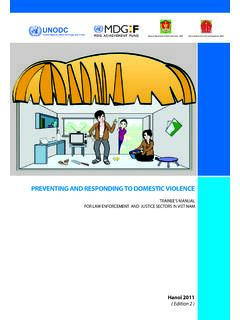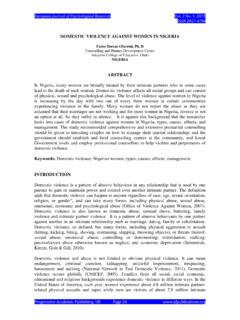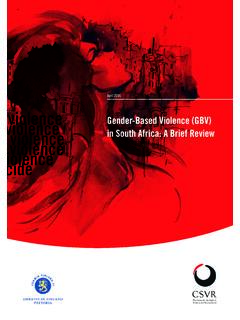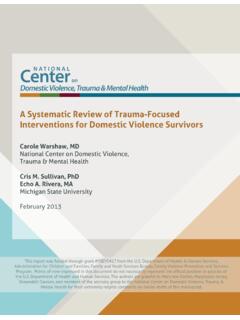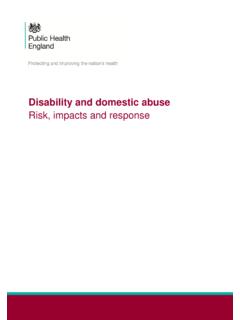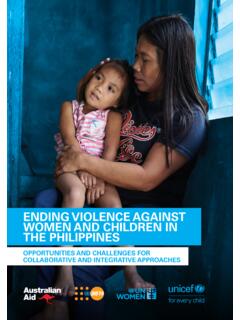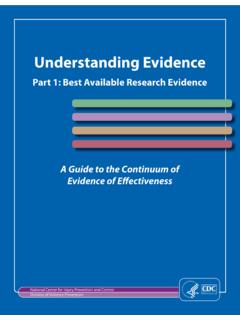Transcription of Sexual violence and sexual harassment between children …
1 Department for Education Sexual violence and Sexual harassment between children in schools and colleges Advice for governing bodies, proprietors,headteachers, principals, senior leadership teams and designated safeguarding leads September 2021 I Contents Summary 3 Part one: What do we mean by Sexual violence and Sexual harassment between Part three: A whole school or college approach to preventing child on child Sexual About this advice 3 Victims and alleged perpetrator(s) 5 children ?
2 6 Context 6 What schools and colleges should be aware of 9 Sexual violence 10 Sexual harassment 11 Harmful Sexual behaviour 12 Part two: What are schools and colleges legal responsibilities 14 Legal responsibilities and equality policies 15 violence and Sexual harassment 17 introduction 17 Extra-familial harms 17 Safeguarding training 18 The role of education in prevention 18 Part four: Responding to reports of Sexual violence and Sexual harassment 23 introduction 23 Support for schools and colleges 23 The immediate response to a report 26 Action following a report of Sexual violence and/or Sexual harassment 31 Ongoing response 40 Safeguarding and supporting the victim 40 Annex A: Further information 50 2 Summary About this advice This is advice provided by the Department for Education (the department).
3 Its focus is child on child Sexual violence and Sexual harassment at schools and colleges. The advice covers children of all ages, from primary through to secondary stage and into colleges and online. For the purposes of this advice, a child is anyone under the age of the focus of the advice is on protecting and supporting children , schools and colleges should of course protect any adult students and engage with adult social care, support services and the police as required. The advice sets out what Sexual violence and Sexual harassment is, how to minimise the risk of it occurring and what to do when it does occur or is alleged to have occurred.
4 The advice highlights best practice and cross-references other advice, statutory guidance and the legal framework. It is for individual schools and colleges to develop their own policies and procedures. It is important that policies and procedures are developed in line with their legal obligations, including the Human Rights Act 1998 and the Equality Act 2010, especially the Public Sector Equality Duty1, and their local multi-agency safeguarding arrangements2. It is important that schools and colleges consider how to reflect Sexual violence and Sexual harassment in their whole school or college approach to safeguarding and in their child protection policy.
5 The advice provides case studies. These are not intended to offer a step-by-step guide, but to provide an indication of some of the many options that are available. The department has updated this advice in line with the revised statutory guidance Keeping children safe in education. We will continue to keep the advice under review. 1 The Public Sector Equality Duty is a legal requirement for schools and colleges that are public bodies. 2 See Working together to safeguard children - ( ) Chapter 3: Multi-agency safeguarding arrangements 3 Who this advice is for This advice is for: Governing bodies of maintained schools and colleges;3 Proprietors4 of independent schools (including academies, free schools and alternative provision academies) and non-maintained special schools; Management committees of pupil referral units (PRUs).
6 Headteachers, Principals and Senior Leadership Teams; and Designated Safeguarding Leads (and their deputies). Other advice and guidance This advice should not be read in isolation. It is important for schools and colleges to consider other relevant advice and guidance, including the following (which is not intended to be an exhaustive list), as part of their approach to protecting children from Sexual violence and Sexual harassment : Keeping children safe in education (statutory guidance for schools and colleges) Relationship Education, Relationships and Sex Education and Health Education (statutory guidance for schools) Working Together to Safeguard children (statutory guidance for schools and colleges) Exclusions from maintained schools, academies and PRUs (statutory guidance for schools) Behaviour and Discipline in Schools (advice for schools) children Missing Education (advice for schools)
7 Cyberbullying (advice for schools) The Equality and Human Rights Commission (provides advice on avoiding discrimination in a variety of educational contexts) Equality Act 2010 and Public Sector Equality Duty (advice for schools) 3 college means further education colleges and sixth-form colleges as established under the Further and Higher Education Act 1992 and institutions designated as being within the further education sector under section 28 of the Further and Higher Education Act 1992 ( designated institutions ) and providers of post 16 Education as set out in The Education and Training (Welfare of children ) Act 2021[1]: 16-19 Academies, Special Post-16 institutions and Independent Training Providers.
8 For colleges the guidance relates to their responsibilities towards children who are receiving education or training at these institutions. 4 In the case of academies and free school trusts, the proprietor will be the trust. 4 Equality Act 2010 Technical Guidance (advice for further and higher education providers) Mental Health and Behaviour in Schools (advice for schools) Rise Above (advice by Public Health England for schools) Preventing and Tackling Bullying (advice for schools) Promoting children and young people s emotional health and wellbeing (advice for schools) Teaching about relationships sex and health (guidance for schools)
9 UKCIS Sharing nudes and semi-nudes: advice for education settings working with children and young people Victims and alleged perpetrator(s) There are many different ways to describe children who have been subjected to Sexual violence and/or Sexual harassment and many ways to describe those who are alleged to have carried out any form of abuse. For the purposes of this advice, we use the term victim . It is a widely recognised and understood term. It is important that schools and colleges recognise that not everyone who has been subjected to Sexual violence and/or Sexual harassment considers themselves a victim or would want to be described in this way.
10 Ultimately, schools and colleges should be conscious of this when managing any incident and be prepared to use any term with which the individual child is most comfortable. For the purpose of this advice, we use the term alleged perpetrator(s) and where appropriate perpetrator(s) . These are widely used and recognised terms and the most appropriate to aid effective drafting of advice. However, schools and colleges should think very carefully about terminology, especially when speaking in front of children , not least because in some cases the Sexual behaviour will have been harmful to the perpetrator as well.










